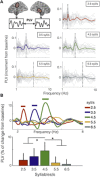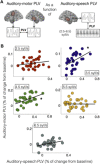The coupling between auditory and motor cortices is rate-restricted: Evidence for an intrinsic speech-motor rhythm
- PMID: 29441362
- PMCID: PMC5810610
- DOI: 10.1126/sciadv.aao3842
The coupling between auditory and motor cortices is rate-restricted: Evidence for an intrinsic speech-motor rhythm
Abstract
The relation between perception and action remains a fundamental question for neuroscience. In the context of speech, existing data suggest an interaction between auditory and speech-motor cortices, but the underlying mechanisms remain incompletely characterized. We fill a basic gap in our understanding of the sensorimotor processing of speech by examining the synchronization between auditory and speech-motor regions over different speech rates, a fundamental parameter delimiting successful perception. First, using magnetoencephalography, we measure synchronization between auditory and speech-motor regions while participants listen to syllables at various rates. We show, surprisingly, that auditory-motor synchrony is significant only over a restricted range and is enhanced at ~4.5 Hz, a value compatible with the mean syllable rate across languages. Second, neural modeling reveals that this modulated coupling plausibly emerges as a consequence of the underlying neural architecture. The findings suggest that the temporal patterns of speech emerge as a consequence of the intrinsic rhythms of cortical areas.
Figures





References
-
- Tremblay S., Shiller D. M., Ostry D. J., Somatosensory basis of speech production. Nature 423, 866–869 (2003). - PubMed
-
- F. H. Guenther, Neural Control of Speech (MIT Press, 2016).
-
- Wilson S. M., Saygin A. P., Sereno M. I., Iacoboni M., Listening to speech activates motor areas involved in speech production. Nat. Neurosci. 7, 701–702 (2004). - PubMed
Publication types
MeSH terms
Grants and funding
LinkOut - more resources
Full Text Sources
Other Literature Sources
Miscellaneous

